The Evolution of Vintage Vending Machines
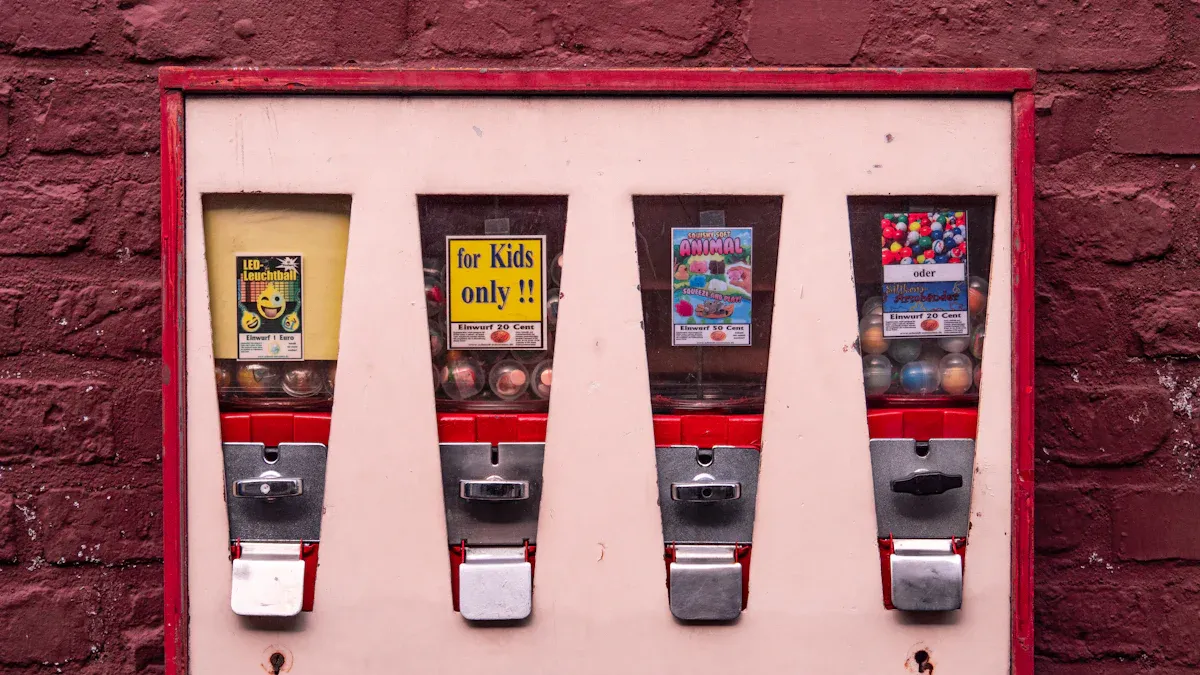
A person stands before a vintage vending machine, its chrome edges gleaming under soft lights. The clink of a coin echoes, and a soda bottle slides out, sparking memories of a bygone era. Vending machines have transformed from simple dispensers to high-tech providers of snacks, electronics, and even prescription medicine. Over time, the history of vending machines reveals surprising milestones, from ancient coin-operated holy water dispensers to mysterious machines that once offered rare sodas in Seattle. Today, vending technology reflects changing lifestyles and innovations.
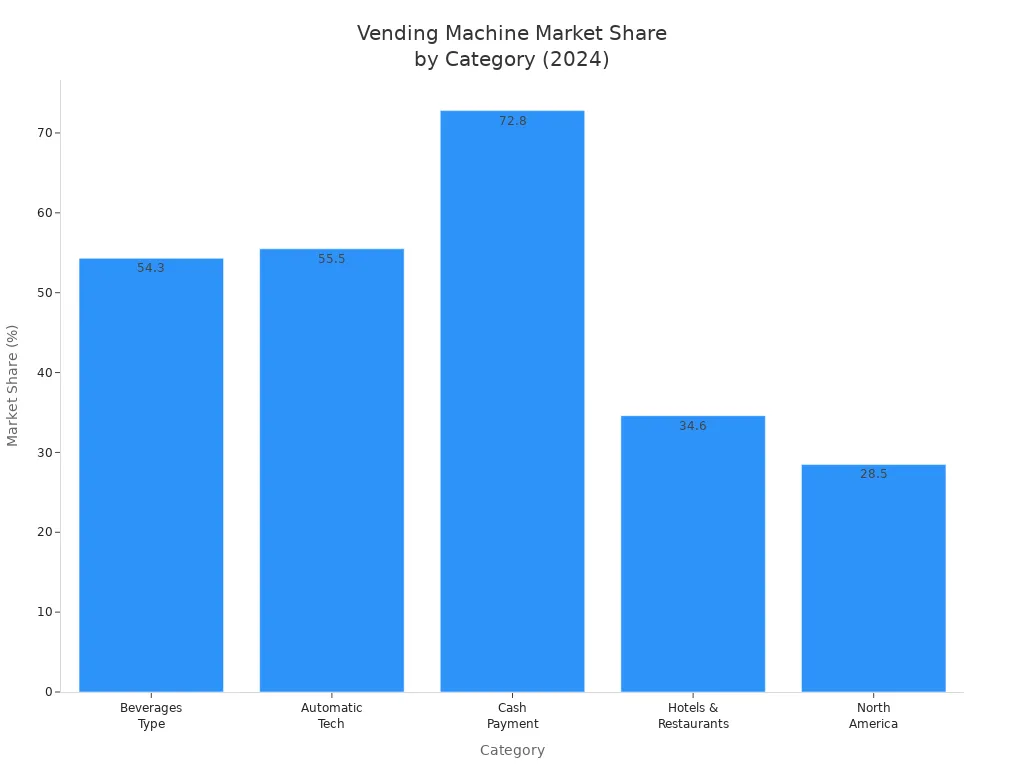
People of all ages still feel a sense of nostalgia when they encounter vintage vending machines, connecting the present to the rich history of vending.
Key Takeaways
Vending machines began in ancient times with Hero of Alexandria’s coin-operated holy water dispenser, marking the first known vending device.
The 19th century introduced automatic machines for stamps, postcards, and gum, making everyday items easier to buy in public places.
The 20th century saw vending machines expand to snacks, drinks, and even cigarettes, becoming common in schools, offices, and public spaces worldwide.
Modern vending machines use digital technology, cashless payments, and smart features like AI and IoT to improve convenience and efficiency.
Sustainability is a growing focus, with energy-efficient designs, eco-friendly materials, and waste reduction helping vending machines support a greener future.
Ancient Origins
Early Vending Machines
The story of vending machines begins in ancient times. The first vending machine appeared in the 1st century AD. Hero of Alexandria, a Greek engineer, invented a device that amazed temple visitors. This machine dispensed holy water when someone inserted a coin. People in ancient Greece and Rome saw this as a clever way to control the use of sacred water.
John Humphrey, a professor of Greek and Roman studies, explains that temples needed a way to regulate holy water. The vending machine solved this problem by giving out a set amount of water for each coin.
The earliest known vending machine was invented by Heron of Alexandria.
It worked as a coin-operated holy water dispenser.
The machine used a lever system. When a coin dropped in, it triggered a beam to lift a plug, letting water flow out.
This invention is recognized as the first vending machine in recorded history.
Hero of Alexandria
Hero’s vending machine used a smart mechanism. A worshipper dropped a coin into a slot. The coin landed on a pan attached to a beam. The weight of the coin made the beam tip, opening a valve. Holy water flowed out for the worshipper to collect. When the coin slid off the pan, a counterweight snapped the valve shut.
1. The machine dispensed holy water in temples. 2. A coin dropped onto a pan at one end of a beam balance. 3. The weight lifted the opposite end, opening a valve. 4. Water flowed out for a short time. 5. The coin slid off, and the valve closed again.
This device showed Hero’s advanced engineering skills. His invention stands as the world’s first vending machine. It marked the beginning of vending machine history and inspired later automated devices. Other inventions by Hero, such as the aeolipile and wind-powered organ, were also automated but not coin-operated vending machines. The history of vending machines starts with this remarkable achievement, showing how ancient people valued both technology and fairness.
19th Century Developments
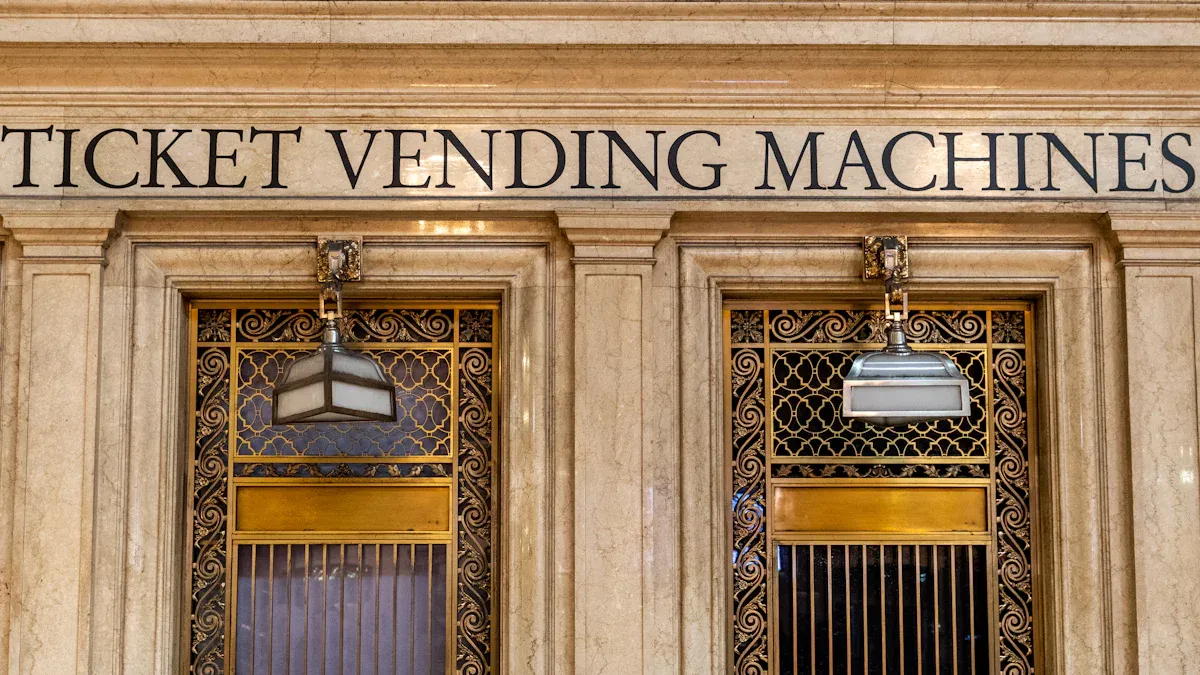
Stamp and Postcard Machines
The 19th century marked a turning point in vending machine history. Inventors introduced new machines that made everyday items more accessible. In 1867, Simeon Denham patented the first fully automatic stamp vending machine. This device allowed people to buy stamps without waiting in line at the post office. Soon after, other inventors created machines that dispensed newspapers, books, and gum. Richard Carlile’s 1822 newspaper vending machine helped people get information quickly and anonymously.
Vending innovations continued to spread. By the 1880s, coin-operated machines appeared in public places across England. These machines sold postcards, letter paper, and even sweets. The introduction of these machines made communication easier and faster. People could now buy postcards at railway stations and post offices, helping them stay in touch with friends and family.
Vending advancements in the 19th century included:
Coin-operated mechanisms for stamps, newspapers, postcards, and gum.
Penny scales that offered both entertainment and practical use.
Large-scale chocolate vending machines in Germany by 1893.
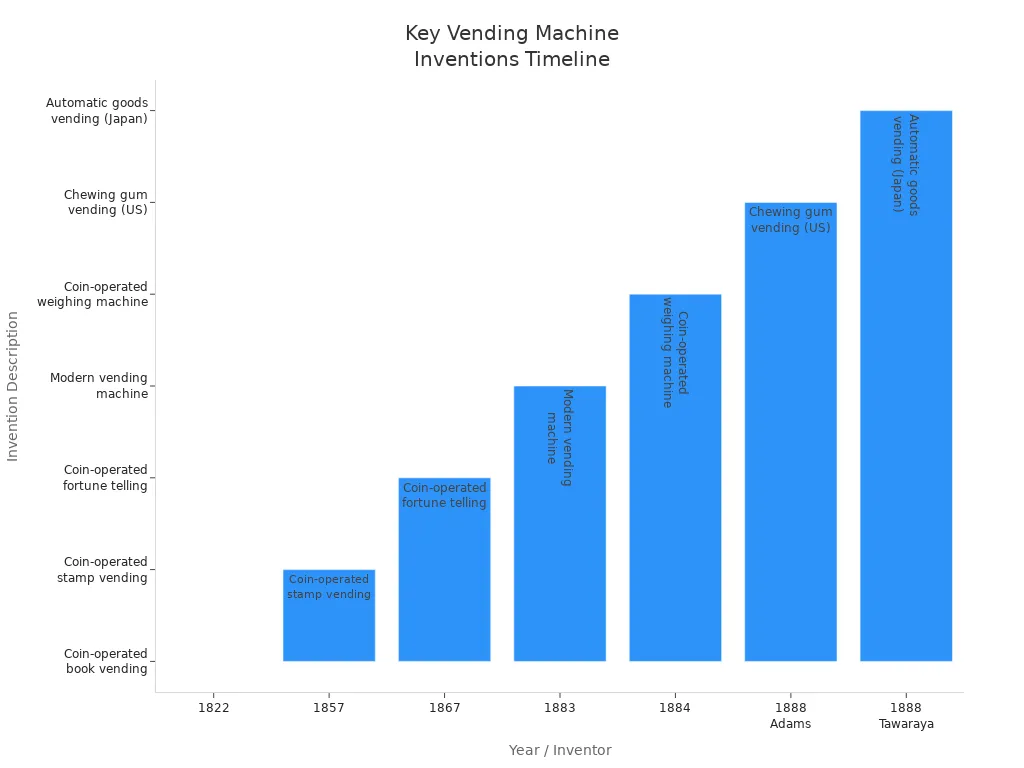
Percival Everett’s Innovations
Percival Everett played a key role in the popularization of vending machines in England. In 1883, he patented a machine that dispensed postcards, envelopes, and notepaper. Everett’s machines appeared in busy public spaces like railway stations and post offices. This innovation made vending practical and convenient for everyone. People could now buy writing materials at any time, which helped speed up communication and commerce.
Everett’s success inspired others. His machines set a standard for future vending machines and showed how technology could meet public needs. By the late 1800s, vending machines had become a visible part of daily life. The history of vending machines shows how these advancements shaped modern consumer habits.
Year | Inventor/Patent Holder | Invention/Patent Description | Significance |
|---|---|---|---|
1867 | Simeon Denham | Coin-operated stamp vending machine | First fully automatic vending machine |
1883 | Percival Everett | Postcard, envelope, and notepaper vending machine | Popularized vending in public spaces |
These milestones highlight the rapid growth of vending and the importance of innovation in making goods more accessible.
Vintage Vending Machines in the 20th Century
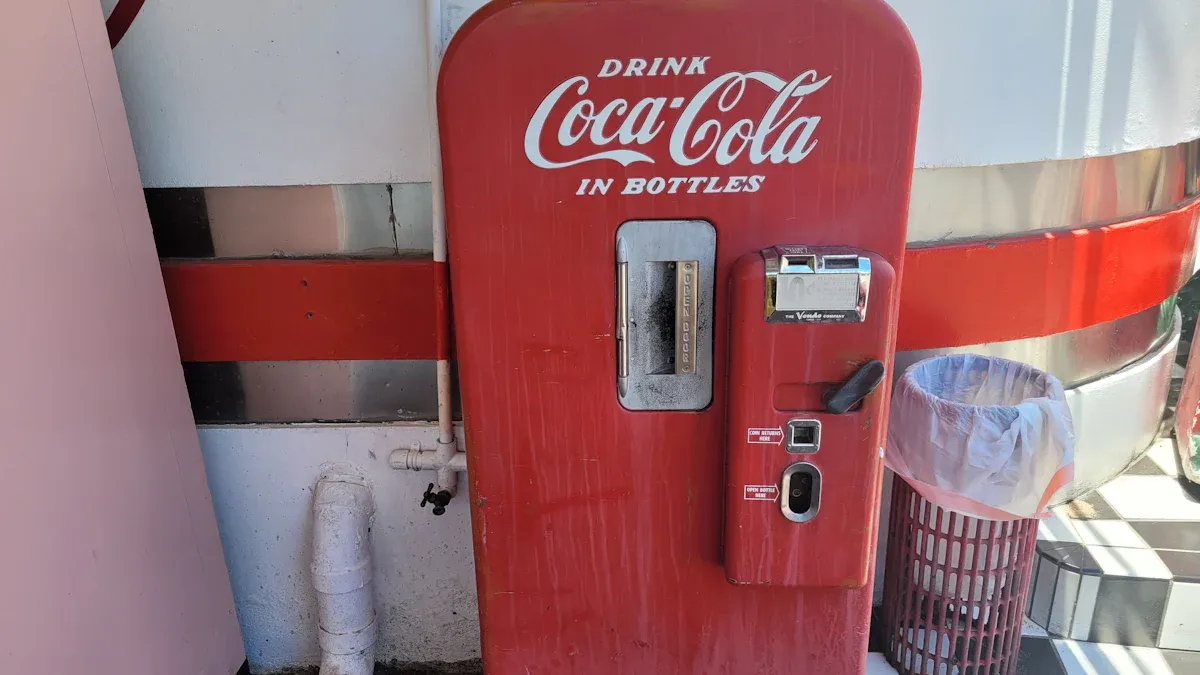
Product Expansion
The 20th century marked a major turning point in the history of vending. Early in the century, most machines dispensed simple items like gum, candy, and soda. As technology advanced, the range of products available in vending machines grew rapidly. Refrigeration allowed machines to offer cold drinks and perishable snacks. By the 1960s and 1970s, snack and beverage vending machines became a common sight in schools, offices, and public spaces.
Vending machines started to sell a wide variety of goods, including sandwiches, milk, ice cream, and even small toys. Digital displays, touchscreens, and cashless payment systems made the experience easier and more appealing. The vending machine industry saw huge growth, with the global market valued at $42 billion in 2023 and expected to reach nearly $72.5 billion by 2030. This growth shows how much product diversity and technology have changed the vending machine revolution.
Japan and the United States led the way in the spread of vending machines. Japan became famous for its high density of machines, with about one for every 23 people. These machines offered everything from drinks to umbrellas, reflecting both cultural trends and consumer needs.
Country | Number of Machines (circa 2017-2018) | Density (machines per person) | Industry Worth (USD) |
|---|---|---|---|
Japan | 4,271,400 | ~1 per 23 people | Over $45 billion annually |
USA | 5 million | Lower density than Japan | More than $25 billion annually |
Vending machines changed retail culture by providing 24/7 access to snacks and drinks in places like schools, hospitals, and train stations. They also supported local economies by selling regional products and even art. In some communities, vending machines supplied health items, showing their ability to meet changing needs.
Cigarette Vending Machines
Cigarette vending machines became a symbol of convenience and modern design in the mid-20th century. These machines appeared in bars, restaurants, and public spaces across the United States and Europe. They made it easy for adults to buy cigarettes at any time. However, they also created problems. Many minors used these machines to buy cigarettes, which led to concerns about youth smoking.
Cigarette vending machines gave minors easy access to tobacco. Studies found that up to 88% of minors could buy cigarettes from machines, compared to 67% from stores.
These machines became part of the tobacco retail environment, but enforcing age restrictions proved difficult.
Governments introduced regulations to limit youth access. Some places required locking devices or restricted machines to adult-only areas. These measures often failed or were hard to enforce.
Community efforts, such as police stings and retailer licensing, helped reduce illegal sales and youth smoking rates.
Public support for banning cigarette vending machines grew, even among smokers.
As a result, the number of cigarette vending machines dropped sharply. Many old machines found new life as art dispensers. The Art-o-mat project, started by Clark Whittington in 1997, turned vintage cigarette vending machines into art vending machines. These machines now dispense small artworks in places like libraries, hotels, and galleries. The project supports artists and keeps vintage vending machines as cultural artifacts.
The Art-o-mat initiative shows how vintage vending machines can become symbols of creativity and community. By dispensing art instead of cigarettes, these machines connect people to both history and culture.
Post-War Boom
After World War II, the post-war economic boom changed the vending machine industry. People had more money to spend, and they wanted quick, convenient ways to buy food and drinks. Factories and offices used vending machines to keep workers happy and productive. The demand for vending machines grew so fast in the late 1940s that manufacturers struggled to keep up.
In the 1950s, vending machines began to offer more than just snacks and cigarettes. Some machines sold complete meals, making them popular in workplaces and public spaces. Sales through vending machines soared from $600 million in 1946 to $2.5 billion by 1960. New inventions, like the slug rejector, made machines more reliable and secure. This encouraged more businesses to invest in vending.
The popularity of vending machines spread around the world. Japan became a leader in the industry, with millions of machines offering a wide range of products. The United States also saw rapid growth, with vending machines becoming a part of daily life.
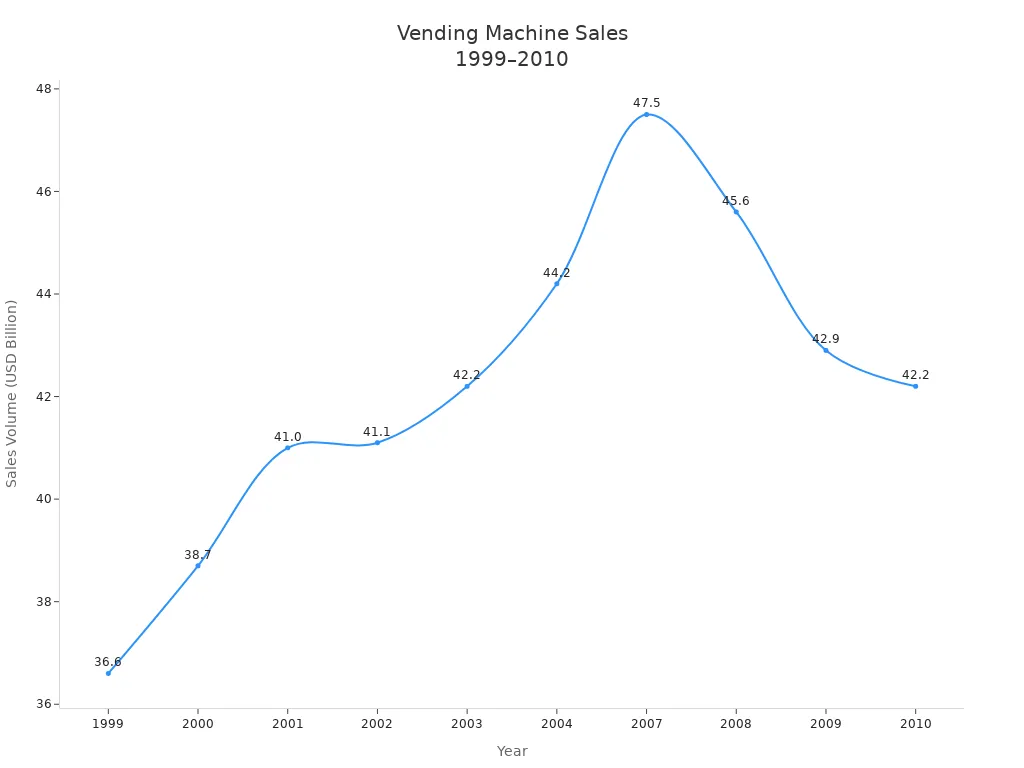
The chart above shows how vending machine sales changed from 1999 to 2010. Sales peaked in 2007, then dropped during the economic downturn, but the industry remained strong.
Vintage vending machines from this era still hold nostalgic value. Many people remember the excitement of dropping a coin into a machine and watching their favorite snack or drink appear. Today, these machines remind us of a time when vending was new, exciting, and full of possibilities.
Modern Vending Machine History
Technology and Automation
Modern vending machines have changed dramatically from their mechanical ancestors. The late 20th century saw a shift from simple levers and gears to electronic systems. Digital interfaces replaced mechanical buttons, making the machines easier to use. Interactive displays now guide users through product choices and payment steps. These advancements improved the user experience and made vending more reliable.
Key technological innovation included the use of microprocessors and software controls. Machines could now handle multiple products, accept different payment types, and give change. Refrigeration technology allowed vending machines to offer fresh food and cold drinks. By the 2010s, touchscreens, internet connectivity, and digital payment options became common features.
Period | Technological Innovation | Description |
|---|---|---|
1950s | Basic Mechanical Machines | Early vending machines were simple mechanical devices dispensing basic items like gum and cigarettes. |
1980s | Electronic Mechanisms | Microprocessors and software controls enabled handling multiple products and payment methods. |
2000s | Refrigeration Technology | Cooling and insulation allowed vending of perishable items such as fresh food and beverages. |
2010s | Digital and Smart Features | Touchscreens, internet connectivity, and expanded payment options including NFC and biometrics. |
Modern vending technology innovations have made machines smarter and more efficient. Real-time inventory tracking helps operators restock before products run out. Digital vending machines provide detailed product information and faster transactions. Personalized advertising and improved security features have increased both functionality and safety.
Today, a modernised vending machine can offer snacks, electronics, and even prescription medicine with just a few taps on a screen.
Cashless and Smart Vending
The rise of cashless payments has transformed the vending industry. People now use credit cards, mobile wallets, and even cryptocurrency to buy products. Cashless and contactless payment systems make transactions faster and more secure. This convenience encourages more frequent and spontaneous purchases.
Smart technology, such as IoT and AI, has changed how vending machines operate. IoT integration allows real-time monitoring of inventory, sales, and machine status. Operators can optimize restocking and reduce waste. AI enables advanced data analytics for personalized product recommendations, dynamic pricing, and predictive maintenance. These features improve operational efficiency and customer experience.
AI-powered vending machines greet users and suggest favorite products.
IoT connectivity enables remote monitoring and reduces downtime.
Smart vending machines support touchless payments and personalized experiences.
Predictive maintenance keeps machines running smoothly.
Smart vending machines have become more common worldwide. In 2023, the global smart vending machine market reached a value of $2.1 billion. Experts expect the market to nearly triple by 2028, driven by demand for cashless transactions and digital features.
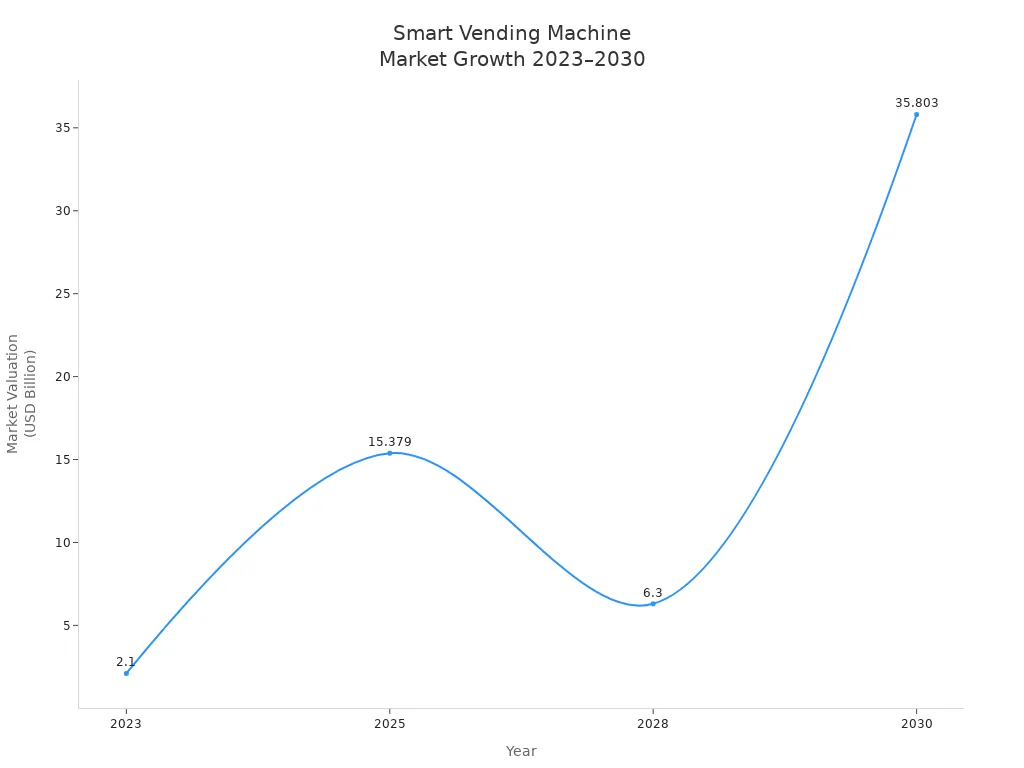
Smart vending machines now appear in public transport, retail, healthcare, and entertainment. They offer 24/7 access to a wide range of products. These machines use advanced software and sensors to automate inventory management and self-report maintenance needs. They accept many payment methods and use AI to analyze purchasing patterns. Interactive displays and gamification features improve engagement.
Older machines required exact change and offered limited products. Modern vending machines use touchscreens, cashless payments, and AI-powered tracking. They provide a diverse product range, including healthy snacks, hot meals, and electronics. Energy-efficient designs and real-time monitoring reduce downtime and improve satisfaction.
Sustainability Trends
Sustainability has become a key focus in modern vending. Manufacturers now use energy-efficient lighting, refrigeration, and even solar power to reduce environmental impact. Many machines use LED lighting and energy-saving modes to lower electricity use. Some vending machines run on solar power, especially in countries like Japan.
Design improvements include the use of recycled or biodegradable materials. Companies like TOMRA aim for machines with at least 90% sustainable materials. They also design machines for easy reuse and recycling at the end of their life cycle. Digital screens replace printed ads, reducing paper waste.
Solar-powered vending machines lower carbon footprints.
LED lighting and efficient refrigeration save energy.
Machines built with recycled materials reduce environmental impact.
Smart inventory management minimizes waste and optimizes restocking.
Recycling compartments encourage responsible disposal of packaging.
Healthy, organic, and locally sourced snacks meet consumer demand and reduce carbon emissions.
Sustainability Initiative | Evidence of Effectiveness | Example/Source |
|---|---|---|
Energy Efficiency | ENERGY STAR® certified machines reduce energy consumption by up to 40%, lowering energy costs and carbon emissions. | MSS Vending machines |
Waste Reduction | Real-time inventory tracking reduces product spoilage and waste; fewer restocking trips reduce fuel emissions. | MSS Vending operations |
Eco-Friendly Materials | Use of environmentally friendly packaging and organic snacks reduces ecological impact. | MSS Vending healthy vending |
Public Image and Consumer Appeal | ENERGY STAR® labeling and sustainability messaging enhance brand image and align with ESG goals. | Corporate and public spaces |
ESG Goal Alignment | Energy-efficient vending supports corporate sustainability strategies and helps meet regulatory expectations. | MSS Vending partnerships |
Some companies offer water vending with reusable glass bottles or stock machines with organic snacks. These efforts help reduce waste and support a greener future. Challenges remain, such as higher upfront costs and the need for consumer education. However, the industry continues to innovate and align with environmental goals.
Sustainability in vending not only protects the environment but also appeals to eco-conscious consumers and supports a better future for everyone.
The journey of vending machines spans from ancient inventions to today’s smart dispensers. Key milestones include the rise of factory vending during WWII, the formation of NAMA, and the introduction of cooled soda machines:
Milestone/Event | Description | Date/Period |
|---|---|---|
Factory vending during WWII | Supported workers with food and drinks | 1939-1945 |
NAMA formation | United vending manufacturers | 1946 |
Expanded product offerings | 1935 |
Vintage vending machines continue to inspire nostalgia and cultural interest. Analysts predict the future will bring AI, IoT, and sustainable features, making vending a seamless part of daily life.
FAQ
What was the first item ever sold by a vending machine?
Hero of Alexandria’s machine dispensed holy water in ancient temples. Visitors dropped a coin into the device. The machine released a set amount of water for each coin.
Why do people collect vintage vending machines?
Collectors value vintage vending machines for their design, history, and nostalgia. These machines remind people of past eras. Many collectors restore them as unique pieces of art or furniture.
How did vending machines change after World War II?
Manufacturers introduced more products and improved technology. Vending machines appeared in offices, schools, and factories. People enjoyed greater convenience and access to snacks and drinks.
Are vending machines still popular today?
Vending machines remain popular worldwide. Modern machines offer cashless payments, healthy snacks, and even electronics. Many use smart technology for better service and efficiency.
See Also
Mountain Dew Vending Machines: Journey From Classic To Cutting-Edge
How Vending Machines Transformed From Snacks To Smart Devices
Antique Vending Machines History: Holy Water To Coca-Cola Era
